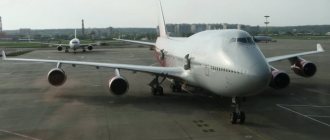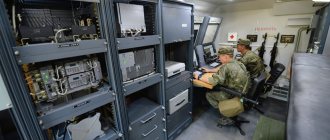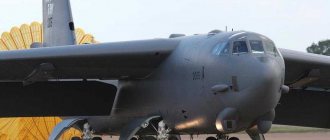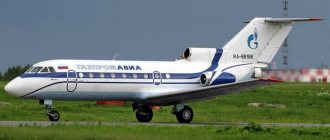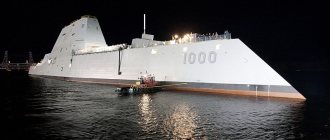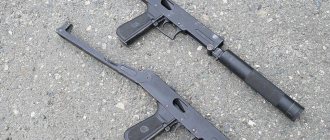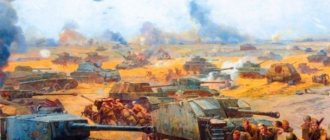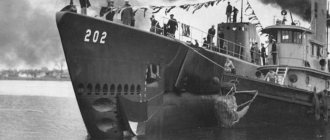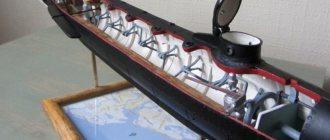MINISTRY OF TRANSPORT OF THE RUSSIAN FEDERATION
STATE CIVIL AVIATION SERVICE
ULYANOVSK HIGHER AVIATION SCHOOL
CIVIL AVIATION (INSTITUTE)
Department of Aircraft Design and Operation
ABSTRACT
in the discipline "Fundamentals of the theory of aviation ergatic systems"
Topic: “Analysis of circuit diagram and algorithms
operation of the ergatic control system of the B737NG aircraft"
Completed by: cadet gr. P-10-6
Nagumanov I.I.
Checked by: Ph.D., Associate Professor
Korneev V.M.
Ulyanovsk 2014
The set of on-board devices that provide control of the aircraft's movement is called the aircraft control system. Since the process of controlling the aircraft is carried out by the pilot in the cockpit, and the ailerons and rudders are located on the wing and tail, there must be a constructive connection between these areas. It should provide high reliability, ease and efficiency of aircraft position control. The main control system of an aircraft includes: ailerons, elevator and rudder. The aircraft's controls are controlled by a redundant hydraulic system; Hydraulic System A and Hydraulic System B. Each individual system can operate all of the aircraft's major controls. The ailerons and elevator can be controlled manually through mechanical wiring. The rudder can be controlled by a backup hydraulic system.
The elements of the auxiliary control system (flaps, slats, spoilers) are controlled by the hydraulic system B, and in case of its failure, by the backup hydraulic system or electrically.
Boeing 737 modifications
Over the long history of the airliner, several modifications of the aircraft, belonging to four generations, have been developed and produced.
| Modification | Year of issue | Flight range, km | Number of passengers, people | Generation |
| Boeing 737-100 | 1967 | 2592 | 103 | Original |
| Boeing 737-200 | 1967 | 3518 | 133 | Original |
| Boeing 737-300 | 1984 | 5000 | 149 | Classic |
| Boeing 737-400 | 1988 | 5000 | 168 | Classic |
| Boeing 737-500 | 1990 | 5200 | 132 | Classic |
| Boeing 737-600 | 1998 | 5648 | 130 | New Generation |
| Boeing 737-700/700ER | 1997 | 6230 | 148 | New Generation |
| Boeing 737-800 | 1998 | 5765 | 189 | New Generation |
| Boeing 737-900 | 2001 | 5800 | 189 | New Generation |
| Boeing 737-900ER | 2007 | 5925 | 215 | New Generation |
| Boeing 737 MAX −7/8/9 | 2016 | 7038/6704/6658 | maximum −140/200/220 | MAX |
Original
The first generation Boeing 737 airliners did not gain much commercial success, as they consumed a lot of fuel, were noisy and expensive to maintain. The last 737-100 aircraft has ceased operation since 2007, and the 737-200 is still used by air carriers in African countries and some other countries.
On the basis of the Boeing 737-200, cargo and cargo-passenger variants were created, and the 737-200 Executive Jet was produced for private owners.
Interesting! Before the Boeing 737 was released, the passenger plane was piloted by 3 people, including a flight engineer. Here, for the first time, a cabin with two pilots was used, which became a revolutionary solution and was adopted as the basis for all subsequent models of passenger airliners.
Classic
Despite all the improvements in the Original generation aircraft, they began to lose significantly to their competitors. The new model has been developed with significant changes. The aircraft received new engines, the fuselage became longer, and the number of passengers carried increased. The aerodynamics have changed, the airliner has been equipped with new digital avionics (on-board electronic systems).
The 737-400 model, due to the enlarged cabin, has changed the internal air conditioning system and added a second pair of emergency exits in the wing area.
The 737-500 version has a shorter fuselage, less capacity, but a longer range.
New Generation
The new generation Boeing 737 has been redesigned even more radically. The wingspan has not only grown, but their geometry has also changed. Amendments were made to the tail unit. The passenger cabins of the New Generation aircraft and the Boeing 757, 767 have a lot in common, since the design of the Boeing 737's interior space was based on the design developments for these airliners.
Each subsequent version of the New Generation has a greater length with an almost unchanged fuselage diameter, and the engines of the latest modification 737-900ER, thanks to the improved wing design, consume less fuel at cruising speed.
Interesting! Based on the Boeing 737-700, 737-800 and 737-900, BBJ, BBJ2 BBJ3 (Boeing Business Jet) are produced, which are the most popular in the world among private clients. On board, at the request of the customer, a bedroom, shower room (bathtub), room for business meetings, etc. are arranged.
Other controls
In addition to the main control organs, the ship has additional ones. They are not present in all aircraft. Among these bodies are:
- main flight instrument (available on the Boeing 737);
- navigation display (electronic device);
- flight mode selection panel.
Modern aircraft contain a large amount of electronics. The navigation display and flight instrument display key information about the flight, aircraft position, speed and other important parameters. To broaden your horizons, it is advisable to know about the new control bodies of the apparatus. Before starting piloting, a civil aviation pilot studies information about the features and unique features of the aircraft he will fly.
Primary flight instrument. 1 – FMA (Flight Mode Annunciator). Indicates the operating modes of the autothrottle and aircraft trajectory control system; 2 – Speed indicator block; 3 – Artificial horizon; 4 – Autopilot operation indicator; 5 – Height indicator block; 6 – Vertical speed indicator; 7 – Course and heading indicator.
Electronics control is performed by the aircraft commander and co-pilot. After an airliner takes off, the autopilot is often turned on by switching the flight mode on the selection panel.
Would you like to learn how to fly an airplane?
Not really
Business Class
Business class has soft, comfortable seats with a wide recline angle. The location of seats in most layout options is according to the 2-2 scheme. In total, there are from 2 to 5 rows in the bow cabin. Most often - 4 rows.
At the front of the aircraft, in front of the seats, there is a kitchen for luxury cabin clients and restrooms. The most relaxing places are the 2nd and 3rd row seats. The 1st and 4th row seats may not seem as comfortable due to the presence of nearby toilets, a kitchen and, in the case of the last row, the more crowded economy class. On some airlines, economy class is separated only by a curtain.
Economy class
In almost all economy class cabins, the seats are arranged in a 3-3 pattern. There are luggage racks on top. The restrooms and kitchen are located at the rear of the plane.
All airlines consider the most comfortable seats on the Boeing 737 to be the first row, right behind business class. It provides more legroom. Often tickets for this row are more expensive or sold to bonus card holders.
Inside the cabin, in the middle part, there is one paired emergency exit or two, depending on the version of the aircraft. Seats near emergency exits also have an increased distance between seats, but passengers may be uncomfortable with the rigid fixation of the seat backs and the side bulges on the side of the aircraft. But the seats immediately behind the emergency exits recline completely and have expanded space. The numbering of rows is confirmed with the carrier.
Important: The worst seats are in the last row of the aircraft. The proximity of the bathrooms and kitchen creates bustle and noise, and the seat backs do not recline or recline slightly.
Design features and benefits
Each aircraft component has its own characteristic features and associated advantages:
- The design of the airliner is a monoplane with two engines placed on pylons and swept wings.
- The three-wheel chassis has a front swivel strut. The main support is not closed by the doors after folding is completed. This can be seen by the visible wheels. This solution simplified the design and reduced the weight of the aircraft, but somewhat worsened the aerodynamics.
- Since the engines are located low, it was necessary to slightly reduce their vertical dimensions. To do this, part of the lower equipment for the engine was placed on the sides and the air intake was slightly extended horizontally. The engines have a flattened shape, especially noticeable in the latest versions.
- The winglets (tips) on the wings underwent changes during the evolution of the Boeing 737. At first, minimal-sized winglets were made on the 737-200 modification. Subsequent generations, Classic and New Generation, received the large winglets that are now widespread. MAX generation aircraft use double winglets.
Interesting: Fuel consumption is reduced by 3.3% when using large winglets and by 5.5% when using double winglets.
- The Messier-Bugatti company equipped the airliner with carbon brakes in 2008. This made it possible to reduce weight by 320 kg and reduce fuel consumption by about half a percent.
- The cockpit, with seating for two pilots, originally had analogue devices and instruments. Now all aircraft are equipped with digital control systems with liquid crystal displays. Previously, the cabin had additional windows on top, which improved visibility when maneuvering and made it possible to navigate the starry sky. Later they were removed due to the installation of modern orientation devices.
- The most serious changes were made to the interior of the cabin. For almost every generation of airliners, it was redesigned taking into account increased comfort and optimal arrangement of passenger seats.
General advantages of the Boeing 737:
- ease of takeoff, climb, landing;
- high load capacity;
- reliability and long service life;
- low maintenance costs;
- comfortable, well-equipped interior.
Main controls
All aircraft (civil and military) have common controls, among which are:
- steering wheel;
- pedals;
- levers;
- various instruments and indicators.
The main control element in any aircraft is the steering wheel. The steering wheel is used to control the ship along the roll and pitch axis.
1 – Spatial position of the aircraft; 2 – Navigation display; 3 – Backup device for aircraft space and position and navigation; 4 – Clock; 5 – On-board computer; 6 – Handle for releasing and retracting the landing gear; 7 – Sadstick; 8 – Autopilot disable button; 9 – Brake pedals; 10 – Fire protection system; 11 – Buttons for turning on fuel pumps; 12 Window opening handle; 13 – Autopilot; 14 – Engine control lever; 15 – Spoiler control switch; 16 – Flap control handle; 17 – Battery switch buttons; 18 – Buttons for controlling air temperature in the cabin and cabin of the aircraft; 19 – Tablet computer; 20 – Aircraft control panel
Civil aircraft control systems are divided into manual, semi-automatic, automatic and combined. The first aircraft had only a manual control system, the operation of which depended on the efforts of the pilot.
Many civil aircraft are controlled in a combined mode. Passenger airliners have an autopilot, which allows you to switch the flight to automatic mode.
If a person wants to get a private pilot's license, then he will need to learn all the controls of the aircraft. In addition, you will need to pass a number of tests, have a sufficient number of flight hours and pass a medical examination.
Steering wheel
By turning the steering wheel to the sides, the roll is adjusted. Pulling toward and away from you allows you to control pitch. Turning the airplane control stick affects the wing ailerons. Pulling toward and away from you allows you to adjust the elevators and elevons. As a result, when the steering wheel is turned left or right, the ship begins to heel. Pulling the aircraft control stick towards you lifts the nose of the aircraft, and pushing away leads to a dive. It is worth noting that signals are transmitted to the ailerons and elevators in mechanical, fly-by-wire or hydraulic mode.
To control a fighter, you first need to study the functions and types of steering wheels. The helm control may contain additional switches responsible for radio communication or the inclusion of specialized modes.
Pedals
Pedals in aircraft are used to operate the rudder. There are two pedals in the cabin. Pressing them determines how the plane turns right and left without roll (the so-called yaw). The pilot must have a keen sense of the pedals in order to correctly adjust the position of the vessel.
It is worth noting that changing the course through the pedals is carried out during the takeoff and run. The steering wheel allows you to slightly adjust the set course. Turning the helm allows you to quickly change the direction of flight through a roll.
To control aircraft, the future pilot studies theory and undergoes practice over a long period of time. Even to fly a small private jet, you will need to have at least 25 hours of flight time with an instructor and meet other requirements.
The complexity of the flight depends on the aircraft control settings and the specific vessel. It is worth noting that on most airliners, most of the flight can take place in automatic mode. Small civil aircraft do not have an autopilot, so you will need to manually control the aircraft's position, speed and other parameters throughout the flight.
Levers
The main levers on an aircraft are considered to be the engine control levers (EC). By acting on the lever, the engine thrust changes. An increase in thrust leads to acceleration of the device, a decrease - to a slowdown. As the thrust increases, fuel consumption increases. If a person wants to know how airplane controls are adjusted, he will need to study the optimal positions of the lever and thrust of the airplane for various situations.
During flight, the engine control lever is almost always set to the idle position to save fuel. The position of the lever must be adjusted based on instrument readings. Control of a fighter aircraft is carried out in the same way as control of a private or multi-role aircraft. On combat ships, you can often find an afterburner mode, which is activated when the control lever is moved to the full throttle position.
Devices
Instruments display flight parameters. A malfunction of instruments poses a serious danger, so when servicing a vessel, pay attention to the operation of individual sensors. Among the aircraft's instruments are:
- altimeter;
- airspeed indicator;
- thermometer;
- attitude indicator;
- tachometer;
- variometer;
- course instruments.
The dashboard displays many different indicators. When seeing aircraft instruments for the first time, a person faces great difficulties. To operate a boat, you need to know the location and purpose of each device.
SU-25 dashboard
Learning about the instrument panel is part of learning to fly. Regardless of what kind of pilot one wants to become, one needs to know the location of all the sensors. It is worth noting that an experienced specialist is able to land a plane in zero-air conditions, guided only by instruments.
Specifications
The operational and technical characteristics of the Boeing 737 have undergone the most significant changes with each new generation.
Original
| Type | 737-100 | 737-200 |
| Length, m | 28,63 | 30,53 |
| Wingspan, m | 28,35 | |
| Fuselage width, m | 3,76 | |
| Cabin width, m | 3,54 | |
| Cabin height, m | 2,19 | 2,11 |
| Maximum take-off weight, kg | 43 998 | 45 359 |
| Cruising speed, km/h | 817 | |
| Engines | P&W JT8D-7 | P&W JT8D-9/9A |
| Maximum flight altitude, m | 10 670 | |
| Run length, m | 1290 | 2058 |
| Fuel capacity, l | 10 758 | 10 515 |
Classic
| Type | 737-300 | 737-400 | 737-500 |
| Length, m | 33,25 | 36,40 | 31,01 |
| Wingspan, m | 28,88 | ||
| Fuselage width, m | 3,76 | ||
| Cabin width, m | 3,54 | ||
| Cabin height, m | 2,20 | ||
| Maximum take-off weight, kg | 56 472 | 62 823 | 52 390 |
| Cruising speed, km/h | 807 | ||
| Engines | CFM56-3B1 | CFM56-3B2 | CFM56-3B1 |
| Maximum flight altitude, m | 10 700 | 11 300 | 11 300 |
| Run length, m | 2012 | 2356 | 1860 |
| Fuel capacity, l | 20 102 | ||
New Generation
| Type | 737-600 | 737-700 | 737-800 | 737-900 | 737-900ER |
| Length, m | 31,24 | 33,63 | 39,47 | 42,11 | |
| Wingspan, m | 34,32 | ||||
| Fuselage width, m | 3,76 | ||||
| Cabin width, m | 3,54 | ||||
| Cabin height, m | 2,20 | ||||
| Maximum take-off weight, kg | 56 245 | 70 080 | 79 015 | 74 389 | |
| Cruising speed, km/h | 852 | ||||
| Engines | CFM56-7B18 CFM56-7B20 CFM56-7B22 | CFM56-7B20 CFM56-7B22 CFM56-7B24 CFM56-7B26 CFM56-7B27 | CFM56-7B24 CFM56-7B26 CFM56-7B27 | ||
| Maximum flight altitude, m | 12 500 | ||||
| Run length, m | 1799 | 1677 | 2241 | 2408 | 2450 |
| Fuel capacity, l | 20 894 | ||||
MAX
| Type | 737 MAX 7 | 737 MAX 8 | 737 MAX 9 |
| Length, m | 33,7 | 39,5 | 42,2 |
| Wingspan, m | 35,9 | ||
| Height, m | 12,3 | ||
| Cruising speed, km/h | 842 | ||
| Maximum take-off weight, kg | 72 303 | 82 191 | 88 314 |
| Engines | CFM International LEAP-1B | ||
Boeing 737 NG is finally being discontinued
Boeing is ending production of the 737 NG narrowbody aircraft, which included the 737-600, 737-700, 737-800, 737-900 and 737-900ER variants. Details: According to a number of sources, two Boeing 737-800s remain to be delivered to customers: one for the Japanese low-cost airline Skymark Airlines, the other for KLM; they are in the final stages of production. This information, which appeared in Telegram channels, is not entirely accurate.
Aeroflot Boeing 737-800
Boeing's website indicates that 5 more Boeing 737-900ERs have not been delivered to the American Delta Airlines out of 130 (however, in fact, 129 are already flying), that is, this data is relevant as of the end of April (4 aircraft arrived in May and June). It is also indicated that 12,737-800 of those ordered were not delivered, while the customers were not specified (Unidentified Customer); Currently, 6 aircraft are expected to enter service for China United Airlines, 2 for the Polish government, 1 for China Eastern and 1 for Pobeda (this will be the last, 30th aircraft of this type in the airline’s fleet).
Rossiya Airlines will no longer receive new 737-800s
However, regardless of whether there are two or three aircraft left to build, the plant will cope with this until the end of June. There are no more orders for Boeing 737NG family aircraft.
Boeing 737-800 S7 Airlines in the process of repainting
It turns out that for some time Boeing will not deliver narrow-body aircraft at all: the 737 MAX family, which replaced the NG, was found to have serious design flaws that led to two plane crashes, and now all aircraft of this type are banned from operation worldwide until the deficiencies are corrected . The date for the resumption of flights was repeatedly postponed; We are now talking about early August 2022. Some airlines have already canceled orders for the 737 MAX; The latest was Azerbaijan's AZAL, which announced on June 3 that it would not take 10 ordered aircraft for safety reasons.
Boeing 737-800 in the new Utair livery
The latest 737 series - both NG and MAX - are often criticized for their archaic design, which dates back to the fifties (many elements are inherited from the Boeing 707): the aircraft, which appeared in the late sixties, has direct control of all aerodynamic surfaces using cables, while on modern cars the system is fly-by-wire (i.e. using electric drives with correction by an on-board computer). The MAX's problems showed that you can't endlessly modernize an old plane; The Airbus A320neo, to which the 737 MAX was made as a competitor, is a more modern aircraft with a larger margin for modernization.
Takeoff of the Boeing 737-800 of Pobeda Airlines. View from the tower (control tower) of Vnukovo airport. In the background is an apron with Transaero Boeings.
Flying since 1988, the Airbus A320ceo, a competitor to the Boeing 737NG, will last longer on the assembly line: the last aircraft will be delivered in 2021-2022; At the moment, 127 vehicles remain to be produced out of 8,139 ordered.
Did you like the article? Subscribe to the channel to stay up to date with the most interesting materials
History of creation
When design work began on the new Boeing 737 in 1964, competitors British Aircraft Corporation and Douglas Aircraft were already well advanced in their production. They were willing to certify new short-haul, low-capacity aircraft. The Boeing company, in an effort to reduce the development time of the airliner, took as a basis the technologies used in the production of aircraft of previous models - 707 and 727. But tests showed the unsuitability of the previous wings for the new version. The newly created wing helped the aircraft fly at higher altitudes, reducing the consumption of aviation kerosene.
The Boeing 737-100 had six seats in each row, providing more seating capacity than competing aircraft manufacturers.
Interesting! Initially, 60 passenger seats were designed inside the Boeing 737-100 cabin, but later they settled on an option with 103 seats at the insistence of the first customer, Lufthansa.
The development program was completed quickly and without investing large amounts of material resources. Assembly of the first aircraft ended in the winter of 1967. In April, the airliner took off for the first time, and in August it made a test flight of the Boeing 737-200.
The decision to operate the aircraft with a two-pilot crew caused serious discussions and resistance from trade unions, as the unit of flight engineer or third pilot was reduced. However, after trials and flight tests, the company proved the possibility of using two people for piloting, and airlines were even interested in it due to cost savings.
At the end of 1967, both versions of the new Boeing were certified, and 2 months later Lufthansa began operating the airliner.
At the same time, the aircraft was being modified so that it could land on a dirt runway. The tests were completed successfully and the Boeing 737 immediately became in demand for flights to distant towns in the northern USA and Canada. The extended model 737-200 was in great demand and was produced until 1988.
In the 80s of the last century, the Boeing 737 was redesigned, equipped with new engines and an improved cabin. The first flight of the next-generation Classic aircraft took place in 1984. Subsequently, two more were added to the 737-300 modification - 737-400, 737-500.
In the 90s, the European A-320 airliner supplanted the Boeing 737 in the narrow-body aircraft segment, possessing technical superiority. And the airline corporation began to create a new series of modifications - New Generation. A total of 5 modifications were produced - 737-600/700/800/900/900ER. Increased cruising speed and more fuel on board made it possible to perform long flights with reduced travel time. Thanks to this, the company opened new markets.
Interesting! New Generation aircraft, except for the fuselage design, are completely different from the first 737 airliners. They have modified engines, completely new wings, and different avionics. Ideas for the interior design of the passenger cabin were even borrowed from the design of the Boeing 777.
The latest version of the NG Boeing 737-900 ER was released in 2007.
In January 2016, the Boeing 737 MAX 8 took off on its first flight. Aircraft of this series are intended to replace New Generation airliners.
Types of engines
Aircraft engines come in different types:
- classic;
- turboprop;
- turbofan;
- direct flow
Classic installations work according to the principle described above. Such engines are installed on aircraft of various modifications. Turboprops operate somewhat differently. In them, the gas turbine has no mechanical connection with the transmission. These installations only partially propel the aircraft using jet propulsion. This type of installation uses the main part of the hot mixture energy to drive the propeller through a gearbox. In such an installation, instead of one there are 2 turbines. One of them drives the compressor, and the second drives the propeller. Unlike classic turbojet engines, propeller engines are more economical. But they do not allow planes to reach high speeds. They are installed on low-speed aircraft. Turbojet engines allow you to reach much higher speeds during flight.
Turbofan engines are combined units that combine elements of turbojet and turboprop engines. They differ from the classic ones in the larger size of the fan blades. Both the fan and the propeller operate at subsonic speeds. The speed of air movement is reduced due to the presence of a special fairing in which the fan is placed. Such engines consume fuel more economically than classic ones. In addition, they are characterized by higher efficiency. Most often they are installed on airliners and large-capacity aircraft.
Ramjet systems do not involve the use of moving elements. Air is drawn in naturally thanks to a fairing mounted on the inlet. After air enters, the engine operates similarly to a classic one.
Some aircraft fly with turboprop engines, which are much simpler in design than turbojet engines. Therefore, many people have a question: why use more complex installations if you can limit yourself to a screw one? The answer is simple: turbojet engines are superior to screw engines in power. They are ten times more powerful. Accordingly, the turbojet engine produces much more thrust. This makes it possible to lift large aircraft into the air and fly at high speed.
While traveling on airplanes, have you ever wondered how a jet engine works? The jet thrust that powers it was known back in ancient times. They were able to put it into practice only at the beginning of the last century, as a result of the arms race between England and Germany.
The operating principle of a jet engine is quite simple, but it has some nuances that are strictly observed during their production. In order for the plane to remain reliably in the air, they must work perfectly. After all, the lives and safety of everyone on board the aircraft depend on it.
Place of production
The geography of production of aircraft components is extensive. These are many European and Asian countries. Assembly work is carried out in the United States.
- The fuselage for the Boeing 737 is assembled at the company's facility in Wichita, Kansas.
- At the second stage, the aircraft body is transported to Renton (Washington State), where final assembly is carried out. Final assembly takes approximately 2 weeks.
Interesting! The assembly of one aircraft requires the installation of 3 million 670 thousand parts and the laying of 58 thousand meters of electrical cables.
Operating companies
Boeing 737 is operated by global airlines in 115 countries. The largest number of aircraft of this type belong to air carriers:
| Company | Number of aircraft, pcs. |
| Southwest Airlines (USA) | 684 |
| Ryanair (Ireland) | 297 |
| United Airlines (USA) | 265 |
| American Airlines (USA) | 244 |
| Delta Air Lines (USA) | 101 |
The aircraft is used for both transcontinental flights and ultra-short flights. This is the main airliner for flights to Alaska, the northern regions of Canada, and the Pacific Islands.
Interesting! The shortest route operated by a Boeing 737 is 14 km. Transportation is carried out by the Japanese Japan TransOcean Air between two islands in the Pacific Ocean (Minami Daito - Kita Daito). Air Tanzania operates flights from Dar es Salaam to Zanzibar Island (65 km).
Boeing 737 is the most popular passenger aircraft
It is difficult to imagine modern civil aviation without the Boieng family of aircraft. These machines fly on all medium and long-range passenger routes, connecting cities and entire countries with each other. The number of aircraft carrying the Boeing logo on board is impressive. To date, this American aerospace corporation has managed to produce and deliver to customers more passenger airliners than others. More than 8 thousand units of Boeing-737 aircraft alone were produced. This figure is an absolute record to date.
New Boeing - a problem with two unknowns
The market for small-capacity passenger aircraft capable of domestic passenger air transportation was a huge field of activity in the early 1960s. The British, with their aircraft from the BAC (British Aircraft Corporation) aircraft manufacturing company, and the McDonnell Douglas aircraft manufacturing corporation could become a monopoly in this segment of passenger ships. Unlike Boeing, the BAC 1-11 and DC-9 passenger airliners were already ready and were undergoing certification stages. In the future, it was planned that these two aircraft could become the basis of the aircraft fleet of most European airlines. The Boeing company, carried away by the construction of long-haul aircraft, could remain on the sidelines when dividing such a huge market. It was decided to correct this situation by creating a new jet passenger aircraft based on the Boeing 727 aircraft.
Today, Boeing-737 300 aircraft, Boeing-737 400 airliners and Boeing-737 500 series aircraft are the main transport vehicles of most of the world's airlines, but then, 50 years ago, the situation for Boeing began with a modest aircraft designed for 100 passenger seats.
The new airliner was supposed to oust British cars and aircraft from MCDonnell Douglas, Boeing's eternal competitor, from the short-haul air transportation market. Work on creating a new machine began in 1964. In order to speed up the process of creating a new aircraft, the existing technological basis used in the construction of the 707 and 727 series airliners was used. The situation was similar in the case of the Boeing 737. The basic machine became the technological platform for the production of the largest series of passenger aircraft in the history of civil aviation. The aircraft, created 50 years ago, continues to fly today. The Boeing 737 800 modification remains today the most popular passenger aircraft on medium-haul airlines, sharing the palm with its European counterpart, the Airbus A320.
Cost of different models
The cost of the first generation models started at $49.5 million, but the price may vary depending on the configuration. Now only modifications of New Generation and MAX are produced.
| Model | Cost, million dollars |
| 737 700 | 78,3 |
| 737 800 | 93,3 |
| 737 900ER | 99 |
| MAX 7 | 87,7 |
| MAX 8 | 106,9 |
| MAX 9 | 113,3 |

